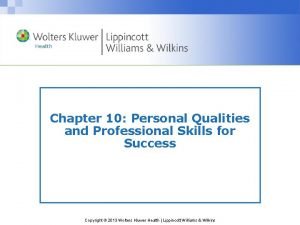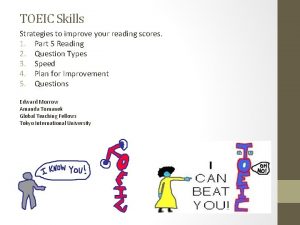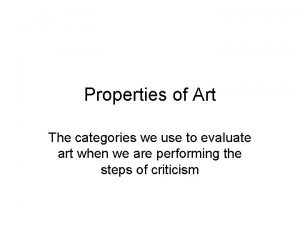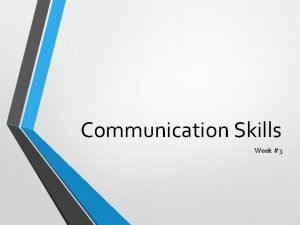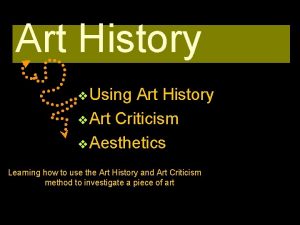COMMUNICATION SKILLS ART OF HISTORY TAKING The qualities












- Slides: 12

COMMUNICATION SKILLS & ART OF HISTORY TAKING

The qualities that patients look for in a doctor Humaneness Competence Accuracy • Honesty Openness Responsiveness Involving the patient in the decision-making process Trustworthiness Time to listen

The duties of a registered doctor The care of your patient is your first concern Protect and promote the health of patients and the public Provide a good standard of practice and care � Keep your professional knowledge and skills up to date � Recognize and work within the limits of your competence � Work with colleagues to serve your patients' interests best Treat patients as individuals and respect their dignity

The duties of a registered doctor Work in partnership with the patient Listen to your patients and respond to their concerns and preferences � Give information in a way they can understand � Respect their right to reach decisions with you about their care � Support patients in caring for themselves to improve and maintain their health � Be honest and open, and act with integrity Act without delay if you have a good reason to believe that you or a colleague may be putting patients at risk � Never discriminate unfairly against patients or colleagues � Never abuse your patient's or the public's trust in you or the profession �

Communication models The biomedical model Doctor is in charge of the consultation Focus is on disease management The patient-centered model Power & decision making is shared Address and treat the whole patient

Key points in the patient centered model Explore the disease and the patient experience with it � Understand the patient’s ideas and the feeling about the illness � Appreciate the impact on the patient’s quality of life and psychological well being Understand the whole person � Family � Social environment � Beliefs Find common ground on management Be realistic � Priorities for treatment � Resources

Communication Skills. Essential Considerations Attitudes � Patients are entrusting their health & personal information to you. � They want someone who is confident, friendly, competent, and above all, is trustworthy

Communication Skills. Essential Considerations Personal appearance: First impressions count and studies have shown that your appearance (cloths, hair, make-up) has a great impact on the patients’ opinion and their willingness to interact with you. � Part of that intangible “Professionalism” comes from your image � Some basic rules for appearance: � Neutralize any extreme tastes in fashion that you may have Men usually wear a shirt and TIE ? ? ? Women my wear skirts or trousers, be careful with the length of skirt The belly and shoulders should be covered even at summer Shoes should be polished and clean Hair should be relatively conservatively styled and no hair should be over the face

Communication Skills. Essential Considerations If in hospital setting, make sure that your discussion is not during an allocated quite time, or immediately before it, you should also avoid mealtimes or when the patient’s long-lost relative has just come to visit.

Essential rules Avoid medical jargon: � The problem is that medics are so immersed in jargon that is becomes part of their daily speech. The patient may not understand the words or may have a different idea as to the meaning � Technical words like myocardial infarction are in obvious need of avoidance or explanation. � Consider terms like exacerbate, or chronic …etc they may seem obvious in meaning to you but not to the patient Remember the name

Some examples of different interpretations Word Your meaning Acute Rapid onset The patient’s understanding Very bad, severe Chronic Long duration Very bad, severe Angina Chest pain associated with ischemic heart disease Specific headache Heart attach, shortness of breath, palpitations Migraine Any severe headache

General principles Demeanor � � � Use appropriate facial expression-don’t look bored Define your role Style of questioning � Give the patient your full attention. Appear encouraging with a warm friendly manner Open versus closed questions Multiple choice questions Clarifying questions Reflective comments Staying on topic Difficult questions Eye contact Interruption Don’t take offence or get annoyed
 The art of history taking
The art of history taking What personality traits do bartenders have
What personality traits do bartenders have Skills and qualities of an entrepreneur bbc bitesize
Skills and qualities of an entrepreneur bbc bitesize Professional and personal qualities
Professional and personal qualities Difference between entrepreneur and manager
Difference between entrepreneur and manager Refusal skills worksheet
Refusal skills worksheet What skills and personnel qualities are required?
What skills and personnel qualities are required? Personal qualities and skills
Personal qualities and skills Test taking skills for middle school
Test taking skills for middle school Taking the toeic skills and strategies 1
Taking the toeic skills and strategies 1 Note taking skills
Note taking skills Properties in art
Properties in art Systematic review in history taking
Systematic review in history taking



